The Tankoviy kostyum (original translation; Tankovij kostjum, in Cyrillics; Танковый костюм (literally; Tankman's costume, unofficially abbreviated as ТК), alternatively also known as the Костюм танкиста (Kostjum tankista/Kostyum tankista, meaning; Costume of tankmen) was once a battledress of Soviet and, nowadays, of Russian origin.[4][5][6][7][8][9][10][11][12].
It was intended for all Soviet tankmen (vehicle crews/operators) in general during the Cold war era, as their standard and indispensable combat as well as working uniform.
As its official designation points, the Tankoviy kostyum was deliberately designated as a costume (a suit - like the infantrymen's KZS, as an example) rather than a coverall (kombinezon - like the KLMK), simply due to the fact that it represented a two-piece battledress: consisting of pants/trousers and a shirt/jacket, which precisely made it what it is by the official Soviet terminology regarding uniforms and equipment - in contrast to the above mentioned KLMK, as an example (which was exclusively one-piece dress and which, exactly due to that, fell into category of coveralls).
However, despite the fact that it consisted of two separated pieces (just like a regular uniform), the Tankoviy kostyum still did not represent an actual uniform in true sense of words (just like the above mentioned KZS), since it was just a combat/working suit, intended to be always worn above their standard-issue obr. 69 service and everyday uniform, which was used by all Soviet Armed Forces personnel.
History & overview[]

The Tankoviy kostyum evolved directly from the previously used model, which was known as Tankoviy kombinezon, as seen here on Red Army T-34-85 crewmen during World War II. The Tankoviy kombinezon was used from late 1930s up until the early 1970s when the newly-introduced Tankoviy kostyum replaced it and, by that, finally ended its almost 40-year long usage for Soviet tankmen. Although very similar at first glance (particularly due to both featuring one-and-the-same color), the major difference between the two was in the fact that the Tankoviy kostyum represented a two-piece suit, in contrast to the kombinezon, which was always one-piece.
The Tankoviy kostyum had evolved directly from the previous, Red Army's tankmen's coverall, which was precisely known as the Tankoviy kombinezon (Танковый комбинезон, literally: Tankman's coverall).[13] The kombinezon originated back from late 1930s and was, thus, commonly used through the entire World War II up until the early 1970s (with some minor changes to the cut after the war).
At first glance, the Tankoviy kostyum was very similar in appearance to the Tankoviy kombinezon, mainly since both were made completely from black-colored textile and both standardly featured integrated suit-alike belt with metallic buckle on pants.
However, there were actually severe differences: firstly, the Tankoviy kombinezon was a one-piece dress - exactly why it was designated as being a kombinezon (a coverall - as same as in KLMK case), rather than being a kostyum (a suit/costume), as the Tankoviy kostyum was, since it represented a two-piece dress (like the KZS), as stated before.
The Tankoviy kombinezon featured only two pockets (single one on the shirt and a single one on the trousers), while the Tankoviy kostyum featured four pockets altogether (two chest-pockets on the shirt, and additional two thigh-pockets, on the trousers). Also, the Tankoviy kostyum finally saw introduction of the winter variant (which included trousers with a lining and a jacket with a fur-filled collar in place of a shirt - as used in regular summer version), a variant which was previously never found in the case of Tankoviy kombinezon (the Tankoviy kombinezon was simply worn with popular white or khaki Bekesha wool-made coats during winter-time).[14]
Furthermore, the Tankoviy kostyum is probably most easily easily distinguished from the previously used Tankoviy kombinezon by another immediately noticeable detail, and that is a distinctive stylized yellow T-62 (nowadays T-90) rubber-made tank patch featured on a dark rhomboid wool-made background[15] - a patch which was always sewn right above the shirt's right chest-pocket, thus indicating affiliation to the branch of the armor troops/units (the Tankovie voyska SSSR).
Apart of the aforementioned chest-patch, the Tankoviy kostyum sometimes also featured either a sleeve-patch of the same armored troops branch,[16] or eventually a sleeve-patch of branches of the Artillery units (Raketniye voyska i artilleriya) as well as of the Air defense units of the ground forces (Voyska protivovozdushnoy oboroni sukhoputnih voysk[17]), that is, only in cases if being worn by the crewmen/operators of the self-propelled artillery or self-propelled air defense systems.
Along with the mentioned chest-patch, these branch-affiliation sleeve-patches represented another detail which was never observed in previously used model, the Tankoviy kombinezon. If present, these patches were located exclusively on the upper-left sleeve - for some reason however, they were in fact randomly present and were not always necessarily included for every individual (in contrast to the T-62 chest-patch, which was absolutely always present in every single example of the summer Tankoviy kostyum versions and sewn above the right chest-pocket by default).
The Tankoviy kostyum ultimately spawned two versions (both which featured summer together with the winter model) - although literally same in design even to smallest possible details, the original/earlier version (made from early 1970s until late 1980s) featured all-out black appearance, while the second/later version (produced from early 1980s until early 1990s) was immediately distinguished from it due to being severely brighter, as it featured a distinctive khaki appearance.
In contrast to most other Soviet-made equipment (which was continued to be extensively used even after the fall of the USSR), the Tankoviy kostyum in its both mentioned models (black & khaki) was produced and used mainly by Soviet (and to very small-scale later Russian) tankmen, that is, through the second half until the end of the Cold war era (from 1972 until 1993).
With dissolution of the Soviet Union, the Tankoviy kostyum was soon phased out from service in the then newly-formed Russian army in 1993 and firstly replaced with essentially the same version but now featuring TCKO (the TTsKO) camouflage pattern, only to be completely replaced simply with common infantryman's uniforms in the same camouflage pattern (as well as in the later, VSR and later Flora patterns) in the second half of 1990s (today in the newest, EMR digital-pattern).
However, beginning as of 2017 and new modernization program of the Russian army, the slightly redesigned Tankoviy kostyum has returned to both production and service, nowadays appearing in dark blue (the so-called Navy blue) pattern and featuring few trivial changes to the cut. Despite this, it appears that the new version is issued in a small scale and still not generally distributed to Russian tankmen as of 2023, since it cannot be spotted almost nowhere in the current Russo-Ukrainian war.
Although common and still relatively easy to acquire in most former Soviet states, the original (Soviet) versions of the Tankoviy kostyum are pretty rare and hard to obtain in rest of the Europe and world (particularly the early/black version), since they are not in production for almost thirty years and since the were used exclusively by the Soviet Army.
Early (black) version[]
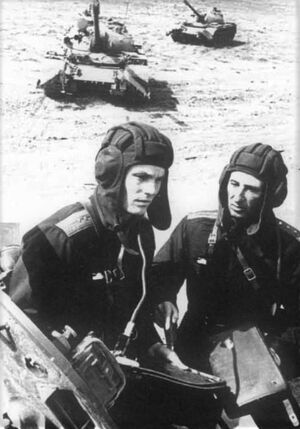
Two Soviet army tank commanders wearing the earlier/black version of Tankoviy kostyum along with their distinctive TSh-4M-L helmets (the summer version), atop of T-55AK tank during training exercise in Siberia in 1975. Leather straps with a buckle means they are carrying the usual officer's brownish map case (see photos below), which was very often used by tank commanders and Soviet army officers in general. Their shoulder boards reveal that the left one is a Captain, while the right one is a Senior warrant officer.
The original (black) model of the Tankoviy kostyum made its first appearance in service of Soviet Army tankmen in 1972, following a regulation through decree No. 92 issued from Soviet Ministry of Defense on 27th April of the same year - simultaneously putting the previously used coverall (the Tankoviy kombinezon) out of commission in both production and usage and, by that, finally ending its almost 40-year long usage for Soviet tankmen (since it was originally worn back from late 1930s and World War II period, with a few trivial changes to the cut in further decades).
Furthermore, following a Defense Ministry decree No. 211 starting from 16th September 1974, the usage of the then-newly introduced Tankoviy kostyum and all of its accessories was also regulated for two other branches of the Army (for the already mentioned Artillery forces and the Air defense units of the ground forces), as well as for members of Soviet Navy, that is, for tankmen of Soviet marines, which were operating PT-76 light amphibious tanks back from 1951 and were previously also using the preceding model (the Tankoviy kombinezon).
However, due to slow process of swapping the old equipment with new within the Soviet Armed Forces, the Tankoviy kostyum was not widely adopted up until 1975 at least and was continued to be regularly paired with almost the same accessories (headwear and footwear), as found in the Tankoviy kombinezon.
In case of headwear, it was paired with the-then recent version of the distinctive Soviet tankmen's helmet, theTSh-4M (Tankoviy shlem, Modernizirovanniy, meaning; Tankman's helmet, Modernized), which featuring a built-in headset, consisting of R-124 intercom (which included twin laryngophones, headphones and a plug - for connecting into the standard Soviet tank radio-device, the R-123 Magnoliya).
The mentioned version of the helmet, which was most often paired with the Tankoviy kostyum had actually appeared earlier than the suit itself - back in the second half of 1960s (so it was still used with its predecessor, the Tankoviy kombinezon), while the TSh-4M as a model was originally introduced back during late 1940s, appearing as a direct result of introduction of the the well-known T-55 - as the first Soviet main battle tank and also the first Soviet tank to be serially equipped with a radio-set (as a standard equipment) intended for internal communication between the crewmen (the so-called "intercom").
However, apart from the existing helmet version (which was already used in the Tankoviy kombinezon), the Tankoviy kostyum did introduce an entirely new headgear - a wool-made black beret[18] (which was regularly worn for everyday use and when not operating vehicles), featuring a frontally worn metallic red star enclosed with a yellow wreath. This beret was another piece never observed in case of the previously used coverall (the Tankoviy kombinezon).
In context of underwear, it was continued to be regularly worn with a basic uniform underneath, in its case, the standard issue and already mentioned obr. 69 (usually known under the unofficial designation M69 - particularly among Western collectors), as a greenish, cotton-made service as well as combat uniform which was worn and used by literally all Soviet Army personnel.
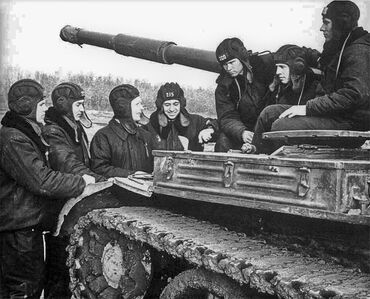
A group of Soviet tankmen at rest beside their T-62A tank in Eastern Siberia, May 1975. They are all wearing the winter version of the early/black Tankoviy kostyum, distinguished by a jacket featuring detachable fur lining around the collar, paired with TSh-4M-Z helmets (winter version, also featuring the fur-filled insides).
Same case was in the context of footwear, as the Tankoviy kostyum was continued to be standardly paired with distinctive and then still regularly used Sapogi leather-made jackboots, which were standardly issued to and used by almost all Soviet Armed Forces personnel (even for battledress/combat uniforms).
As in case of previously mentioned Tankoviy kombinezon, the Tankoviy kosytum was also made out of all-out black textile pattern (a combination of cotton and polyester) and also featured a integrated (suit-alike) belt with a metallic buckle. However, the belt was not entirely the same as the one found in Tankoviy kombinezon, since it introduced a needlepoint and thus, metallic rings on its holes (while the one featured on the Tankoviy kombinezon had just a square buckle, which was simply tightened without a needlepoint and holes).
Reason why the Tankoviy kostyum continued to feature the same dark (black) appearance was the fact that such color was back then seen as the most suitable for tankmen, as it easily and most effectively helped to conceal any spots of fuel, grease, lubricants, engine oil as well as gunpowder (from fired shell cases) - which is naturally expected to spoil their uniform at daily basis while at work (maintaining and operating the combat vehicles). Due to exactly the same reason the World War II German (Wehrmacht) tankmen (the Panzertruppen - Armor troops) wore their all-out black wool uniforms[19][20] (same as their opposing Red Army tankmen of the same period).
As mentioned before, the Tankoviy kostyum, as the newly introduced model, consisted of two pieces (a shirt and the trousers), due to which it was renamed from coverall to costume. Each of those two elements featured two frontal, enclosed pockets with peaked pocket covers (similar to the ones found on the US M65 field-jacket). It also made introduction of the winter variant (as the firstly purposely-designed winter uniform for Soviet tankmen), which featured heavier and thicker trousers and a jacket instead of shirt.
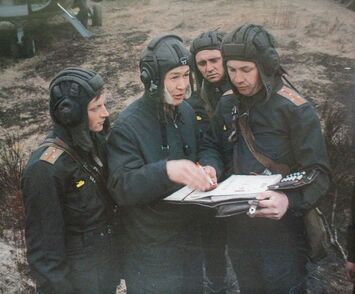
Crewmen of a T-72 tank consulting with an Mi-8 pilot (middle) during the Zapad-81 military exercise, 1981. Like on the first photo, the tankmen (Senior Lieutenant on the left, Captain to the right) are wearing the usual summer black version of the Tankoviy kostyum, paired with TSh-4M-L helmets. The pilot is wearing the standard helicopter pilot's two-piece dark blue suit (the Kostyum letchika), paired with a ShL-78 (ШЛ-78) helicopter pilot's helmet, which also featured an integrated headset.
The jacket was multi-layered internally (one of these layers also being fur-lining), while externally it also featured distinctive dark-grey or black detachable (artificial) fur-lining on the collar and, somewhat unusual, vertical, open side-pockets. The buckling of all suit components was done via both classic plastic buttoning knobs as well as by zip buttoning, which were present on both trousers as well as on the shirt/jacket's sleeves and pockets.
In contrast to the standard summer version (which featured integrated belt on the trousers), the winter version of the Tankoviy kostyum followed opposite logic, as it featured the belt only on the jacket. Because of that and due to naturally being heavier, the winter trousers included wider belt loops instead, intended for pulling through the standard Soviet army brownish leather belt with a metallic buckle (featuring a red star decorated with hammer and sickle) or the standard Soviet officer's belt with a double needlepoint piece. [21][22]
In case of tankman's equipment, those belts served only for carrying the usual Soviet canvas-made magazine pouch on it[23][24] (intended for three AKM or AK-74 spare magazines).
Despite the fact that the Soviet tankmen were officially issued with an AKS-74U automatic carbine as their standard firearm and thus, the belonging pouch containing three spare magazines along with it, they almost never preferred to actually wear nor the rifle nor the pouch on them (along with any other equipment - map case, gas mask bag and other), which is why the above mentioned leather belt (as an additional piece) was rarely seen on them and pretty often left-out (leaving solely the suit-integrated belt).
The reason behind this simply lied in the fact that literally anything worn on Soviet tankmen could seriously hinder them while getting in and out of the tanks through the hatches above (which were also relatively narrow) and what was especially important if they had to quickly bail out when the tank was hit and burning - where literally every second could mean the difference between life and death.
Moreover, tendency not to usually wear anything else on them regarding equipment (beside the sole suits above the standard service uniform) while operating their combat vehicles was also present due to one even more important reason - to avoid any equipment being accidentally snagged into bulky and lethal automatic shell loader's mechanism, located inside the tanks (which was introduced starting with the T-64 and was always located right in between the commander's and gunner's seat, divided from them only by short railing). In more extreme cases, accidental snagging of the equipment into the auto-loader's mechanism could even be of life danger.
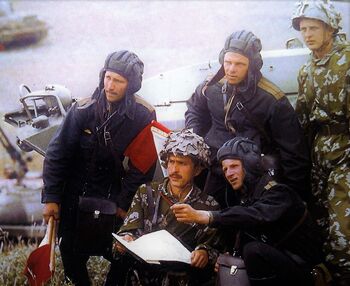
Three tank commanders (officers) behind a BMP-1, discussing movements with mechanized infantry during an exercise, late 1970s. They are also wearing the usual summer version of the early/black Tankoviy kostyum along with standard TSh-4M-L helmet and a map/document case. The two mechanized infantrymen are wearing the KLMK one-piece camouflage coveralls, paired with standard Soviet Army SSh-68 steel combat helmet fitted with artificial foliage.
This cognition then alludes to the logical conclusion why the Soviet and today Russian tankmen are rarely seen sporting a firearm (less indeed a magazine pouch or any other equipment on their belts) while actually operating combat vehicles, as they always preferred to stash the pouch together with the rifle inside the vehicle and then take it out and put onto them only if permanently staying or fighting outside the vehicle (in other words, only if the vehicle is unmanned for a relatively longer period or if it's abandoned, disabled or destroyed).
Precisely due to this experience, both the summer (shirt) as well as the winter (jacket) versions of the Tankoviy kostyum standardly included an internally-sewn chest pistol pocket - as another featured never found in the previously used Tankoviy kombinezon. This pocket was intended for housing the standard-issue PM (Pistolet Makarova), ensuring that it could always be safely carried even inside the vehicle and thus also lessening the necessary need for carrying an automatic rifle (the AKS-74U).
Purely due to distinguishing reasons, the summer variant of the suit is sometimes unofficially abbreviated as the ТКЛ (TKL, meaning Tankoviy Kostyum Letniy, translated as; "Tankman's Costume Summer"), while the winter one as the ТК3 (TKZ, meaning; Tankoviy Kostyum Zimniy, translated as; "Tankman's Costume Winter"). For whatsoever reason, only the summer version standardly came with stylized and already mentioned T-62 tank-patch sewn above the shirt's right chest-pocket, while the winter version (the jacket) never featured it.
On the other hand however, only the winter pants included external white-printed markings depicting a Soviet red-star decorated with hammer and sickle, along with inscription BC (VS, from Cyrillics, abbreviation for Вооружённые Силы, translated as Voorjžjunnij Sili, anglicized as; Vooryzyuhenniy Sili and meaning: Armed Forces), located on the upper left trouser leg.
Both the summer and the winter version of the Tankoviy kostyum's trousers also featured laces on both leg endings, as another new feature which served for tightening of trouser legs to prevent them from dragging or falling out from boot. This was somewhat oddly in fact, particularly since the Soviet tankmen (like all the other Soviet Army personnel) exclusively wore the, already mentioned, Sapogi jackboots (which were, as such, reaching almost as far as up to the knees).

Artist Ronald Volstad impression of standard Soviet army tankmen appearances from early 1970s until late 1980s (from Osprey title Inside the Soviet Army). All are wearing the original/black versions of the Tankoviy kostyum, with winter variant worn in the middle (by one looking through PNV-57 tankmen's night vision), distinguished by its fur-lining on collar. All are also wearing the standard Sapogi jackboots and two of them are using TSh-4 helmets. Two are armed with their standard-issue AKS-74U automatic carbine, while the right one features a GP-5 gas mask along with the OPVT diving equipment (used as a part of training for getting out of combat vehicles if became immobilized under water).
Thus, due to these boot's pretty high profile, it was actually very hard (if not literally impossible) for trouser leg to even slightly drag out and less indeed fall out from boot (almost entirely regardless of the fact whether the trouser legs were tied or not). Therefore, the role of these laces was to tighten the trousers legs only if they were not sticken into the boots (however, that kind of was wearing was rarely practiced and was, officially, against regulations).
Internally, both the shirt (or jacket, in winter version) and the pants/trousers had standardly featured a distinctive white markings printed (as all the other pieces of Soviet uniforms and equipment), in which the size, serial number of production GOST-designation, year and place of manufacturing as well as the cleaning regulations were found[25].
By the mentioned GOST-designation, he Tankoviy kostyum was marked with numbers 24870, which fell into category of Костюмы специальные летние для военнослужащих (anglicized; Kostyumi specialniye letnie dlya voennosluzhashih, translated as; "Special summer costumes for military-personnel"), where it was furtherly divided into a sub-category of Tип-Г (the "Type-G"), indicating summertime tankmen's uniform.
The original (early/black) version of the Tankoviy kostyum was in official usage by the Soviet tankmen from 1972 and remained so until 1983 (which means that it was regularly used in all of their tanks of the period; from T-55 and T-62 through T-64 and T-72 up until T-80) when it was formally replaced with literally the same version, featuring literally nothing else beside the different color (appearance).
However, the black version was nevertheless continued to be used and even produced as far as the very end of the 1980s (when it was finally completely replaced with the later, khaki model), which was contributed to generally very slow process of swapping the old equipment and uniforms with the new ones in the Soviet Armed Forces.
This lasting process of swapping of the uniforms and equipment should not surprise at all however, since the Soviet Army represented one of the largest military force in the history of mankind (counting more than few million men in active service and as fivefold as that in addition/reserve), which is precisely why it usually took at least a few years to entirely complement every single individual with newer gear.
Apart from the sole MBT's, the Tankoviy kostyum was also issued to crewmen of all Soviet ICV's (infantry combat vehicles); the BMP-1, BMP-2 and BMP-3. Furthermore, it was also regularly issued to all crewmen of their SPG's - the 2S1 Gvozdika, 2S3 Akatsiya, 2S4 Tyulpan, 2S5 Giatsint and 2S7 Pion as well as to the operators of short/medium range self-propelled anti-aircraft systems (SPAAG), more precisely, the ones which were assigned directly to armored and mechanized units (as a part of the, already mentioned, Air defense of the ground forces branch) - the ZSU-23-4 Shilka, 9K31 Strela-1, 9K33 Osa, 9K35 Strela-10, 2K22 Tunguska, 2K11 Krug, 2K12 Kub, 9K37 Buk, 9K330 Tor and the 9K81 Antey (S-300V).
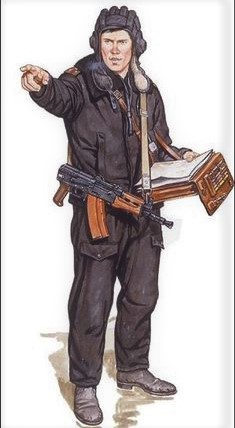
Another artist impression of winter configuration of the early/black Tankoviy kostyum version, showing the Sapogi jackboots not being sticked into the pants, which was relatively rarely practiced. The figure wears the TSh-4M-Z helmet, is also armed with an AKS-74U carbine and issued with the officer's map case.
Moreover, it was issued even to the crewmen of the self-propelled short-to-medium-range (tactical) ballistic missiles used during that period (1970s-80s); that including R-17 Elbrus, OTR-21 Tochka and OTR-23 Oka.
Thus, practically speaking, the Tankoviy kostyum in fact not just solely represented a tankman's suit, but a suit intended for literally all combat vehicle crewmen of the Soviet Army (that including self-propelled howitzers, self-propelled tactical ballistic missiles as well as self-propelled air defense systems).
A somewhat common dispute regarding the Soviet tankman suits is that they were made fire-resistant (like the Nomex-made Bundeswehr Panzerkombi and the USA CVC tankmen coveralls, as an example). This is mostly erroneous belief, as the Tankoviy kostyum together with its predecessor (the Tankoviy kombinezon) in its basic versions (both summer and winter) were always made from the usual cotton, reinforced with additional polyester fibers - for better durability and firmness of the suit (just like the common infantry uniforms) and were thus, generally not intended to provide full fire-resistant features.
However, the special, fireproof version of the tankman suit had actually existed and is usually unofficially abbreviated as ТКО - Танковый Костюм Огнеупорный/Огнезащитный (Tankoviy Kostyum Ogneuporniy/Ognezashitniy, the latter simply meaning - Fireproof/Fire-resistant) in both in black and later khaki versions, firstly appearing back during 1960s (so, even before the original appearance of the Tankoviy kostyum, which debuted in 1972).
The fireproof version featured the usual fire-resistant (nylon) layers above the usual cotton material, different pocket composition and included gloves as well as hood along with a distinctive face-protective fireproof mask (by design similar to the one issued with KLMK coverall). For some reason however, it was very rarely issued and used (only for specific purposes).
Late (khaki) version[]
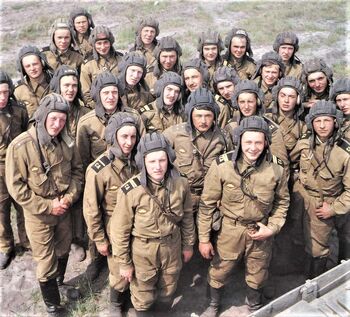
Soviet tankmen posing with their new and then recently received summer khaki Tankoviy kostyum versions during 1980s. Some of them are also already sporting the newest and still latest model of TSh-4M helmets (recognizable by six longitudinal lines on the overhead as well as larger ear coverings due to featuring new sound isolators) which were introduced simultaneously along with the khaki version of the suit and which will become widely distributed yet in the Russian army during early 1990s.
Following a 1982 decree issued from Soviet Ministry of Defense, the Soviet Armed Forces faced a new modernization program, which, among new technology, equipment and weaponry, also included new uniforms for various branches and units.
As a result, the Soviet infantry, marines (the MPR) and paratroopers (the VDV) in the first place, received the all out-new and unique uniform in the following year (1983), which is nowadays in the West often colloquially designated as "M88" (although it appeared earlier than 1988) and which consisted of camouflage/battledress version together with non-camouflage, standard service/everyday version, which was featured in a distinctive khaki color.
The battledress version of the aforementioned uniform actually represented their very first actual camouflage uniform, as it was featured in the so-called ТЦКО[26] (Три-Цветная Камуфлированная Одежда - TTsKO, transliterated as; Tricvetnaja Kamufliorvannaja Odežda, anglicized; Tritsvetnaya Kamuflirovannaya Odezhda and meaning: Three-tone camouflage clothing) pattern. This pattern finally and soon largely started to replace the previously used KLMK and KZS two-tone camouflage coveralls (although both of those were continued to be produced and officially used to this day, but sensibly less than before the appearance of the new TTsKO pattern).
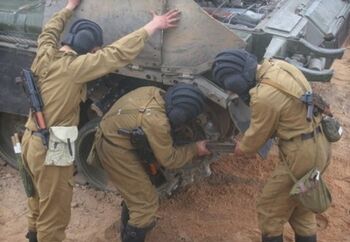
Crewmen of a T-80 tank installing/repairing its track joint during training exercise, late 1980s or early 1990s. Like on the previous photo, they are all wearing the summer version of the later/khaki suit along with the latest TSh-4M-L helmets, but here combined with, rarely observed, tankmen's full-combat equipment; each issued with an AKS-74U carbine along with a separate (leather) belt featuring a canvas magazine pouch and a gas-mask bag over the shoulder (either GP-5 or GP-7).
However, the biggest change was in the introduction of the everyday/service version of "M88" (often popularly nicknamed Afganka, due to originally being issued only to the personnel involved in the Soviet-Afghan war), which was made in distinctive khaki pattern and which finally started to replace the previous and already obsolete obr. 69 uniform (which was until then, often used even as a battledress).
Exactly due to changes regarding uniforms and appearance of the infantry personnel, starting from the same year, the Soviet tankmen also began to adopt a new version of the essentially same suit model as the previous one, whose sole difference was in the fact that it featured the very same khaki color as found in the newly-introduced infantryman's everyday uniform (the Afghanka), instead of the previously used black (as found in the original version of the Tankoviy kostyum).
Following the same logic as with that of the infantrymen's uniform, the khaki version of the Tankoviy kostyum was originally intended to be issued exclusively to the personnel involved in the aforementioned Soviet intervention in Afghanistan, while the rest of the Soviet Army tankmen (the native forces, located within the USSR itself and the Warsaw Pact countries), were to continue sporting of the existing/original (black) version.
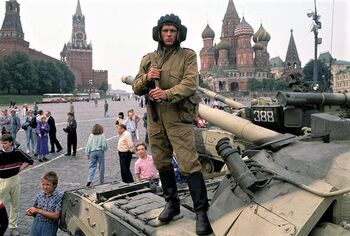
Soviet tankman belonging to the elite 2nd Guards Motor Rifle Division Tamanskaya standing atop of his T-80U tank during unsuccessful August 1991 Coup d'etat in Moscow's Red square. He is also wearing the summer late/khaki version of the Tankoviy kostyum paired along with the latest version of TSh-4M-L helmet, Sapogi jackboots and is armed with an AKS-74U carbine together with its magazine pouch.
Yet later (starting from the late 1980s) the khaki version was slowly starting to be distributed among the rest of the tankmen, meaning that, up until the very end of the 1980s, the original (black) version of the Tankoviy kostyum was still in relatively common circulation. Starting yet from early 1990s and dissolution of the USSR was the process of swapping the black for the khaki version of the Tankoviy kostyum finally completed and the original version was entirely phased out in favor to the later one.
This also assumes that in the period starting from 1983 up until the 1990, the Soviet tankmen could be regularly spotted using both versions (either the early/black or the late/khaki) of the existing suit.
The changing of the color (from black into khaki) which was marked with the appearance of the new version of the existing suit in 1980s had finally marked the change of appearance of Soviet and previously Red Army tankmen after almost fifty years, since they officially wore the all-out black suits/coveralls from late 1930s until the end of 1980s (although, the Red Army tankmen often also unofficially use either the light-grey, brown or dark-blue colored coveralls during World War II, but that was exclusively an alternative which appeared due to severe shortages of the black-colored textile during the wartime).
This color change was most obviously done purely due to standardization reasons and nothing else practical, that is, just in order to match the appearance of tankmen with the mentioned infantryman's Afganka uniforms (since both now appeared in the khaki color, as mentioned). By that, the long-lasting Soviet military philosophy (originating back from World War II period) of tankmen necessarily demanding a dark appearance of their suits in order to hide potential spots (of fuel, oil, grease and gunpowder) was finally abandoned and practically proclaimed as being obsolete.
Except for the color, literally everything else considering the newly-introduced, khaki version of the Tankoviy kostyum (from its sole design to all suit components and features) remained the same as found in the previous version (retaining even the smallest details, like the stylized T-62 patch sewn above the right chest-pocket).
Along with new model of the existing suit, they Soviet tankmen also started to receive an updated model of the existing headset (their TSh-4M helmet), which now featured more-square and much larger (more bulged-out) ear covers (due to having improved noise-reducing layers built-in) as well as six bulged-out, head-protective longitudinal lines altogether on the overhead (two additional at the sides, which replaced the two vertically-diagonal ones, as found in previous version of the existing helmet).
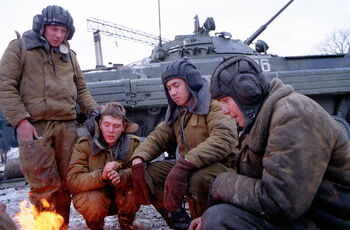
Russian tankmen taking a break behind their BMP-2 near Grozny railway station during the siege of the city in winter of 1994, as part of the First Chechen war. They are all wearing the winter version of late/khaki version of the Tankoviy kostyum, easily recognizable by vertical pockets and fur-lining around collar. This was one of the last usage of this suit in then recently founded Russian army, as it was officially phased out of production and service in favor to camouflage pattern (TTsKO and VSR) uniforms already a year earlier (in 1993).
Regardless of the fact that the color of the sole suit (the Tankoviy kosytum) was changed in the 1980s (in both winter and summer versions), the TSh-4M helmet (as its main headwear) nonetheless remained exclusively in black appearance until the very end of USSR and still continues as such to this day - although, the khaki-made TSh-4M helmets did exist, however, those were produced briefly and in very small quantities, as they were being intended only for tankmen serving in Afghanistan (and, in contrast to the suit itself, they remained so).
In contrast to the mentioned infantrymen's camouflage patterns and uniforms, (which were continued to be extensively used by the newly formed Russian and most other post-Soviet armies as far as early 2010s), the khaki model of Tankoviy kostyum was soon discontinued from both usage and production not long after the breakup of the USSR (in 1993) and was firstly replaced with another model of the existing suit (now featured in the TTsKO or, the later, VSR camouflage pattern).
Those camouflage models of the Tankoviy kostyum were fairly shortly lived, as they too were completely phased-out in favor to common infantryman's uniform (starting from 1998 also featuring then new, Flora camouflage pattern)[27][28][29], by that, for the first time eliminating the difference in appearance of tankmen when compared to infantry (except for the headwear) in Russian Armed Forces which was always present in the Soviet army.
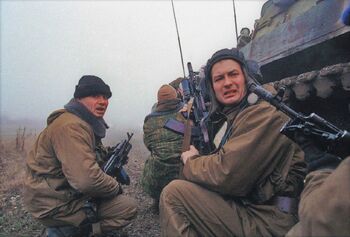
Another photo from the First Chechen war in winter of 1994, showing Russian tankmen along with the belonging mechanized infantry taking cover behind their BMP-2. They are also wearing the winter version of the late/khaki Tankoviy kostyum like on the photo above and are all armed with standard infantrymen's AK-74M automatic rifles fitted with GP-30 grenade launchers, since the previously used AKS-74U carbine was discontinued in both production and usage (for tankmen) a year earlier (in 1993).
This means that the late/khaki model of the Tankoviy kostyum was formally produced and used for barely ten years altogether, since it appeared back in 1983 but was already in 1993 officially phased-out from service and replaced with camouflage pattern suits and, finally, with common infantrymen's uniforms.
However, the khaki model had seen much more usage in various conflicts - being extensively used by Soviet tankmen in the Afghanistan during 1980s (although the black version was firstly also used, but very briefly) and even, to a much smaller scale, commonly by the later Russian army tankmen during the First Chechen war of 1994-1995 (as seen on the photos to the right).
Regardless of that fact it is still relatively easy to find in post-Soviet states (mostly Russia and Ukraine), the late/khaki version of the Tankoviy kostyum is nowadays also harder to acquire in other parts of Europe and world, simply due to the fact it was used exclusively by Soviet and Russian army and since it is not in production for more than twenty years.
Modern (blue) version[]

Modern Russian tankmen wearing the latest/dark-blue version of Tankoviy kostyum, which features a new tank chest-patch (now depicting a stylized T-90 instead of the previously used T-62), paired with the latest model of TSh-4M helmets and standard-issue gas-mask bags across their shoulders.
As of early 2010s, the Russian Armed Forces faced their newest modernization program pursued under policies of the current Defense minister Sergey Shoygu and General staff chief Valery Gerasimov.
This modernization, among other new technology, weaponry and equipment, firstly saw introduction of the new parade uniforms for all branches (similar to the ones worn by the old Russian Empire officers), as well as the new Ratnik (literally; Warrior) program, which, among many other features, introduced the all-out new EMR uniform (the Russian first digital camouflage pattern) as a replacement for the Flora pattern (itself a replacement for previously used VSR), which was officially used from 1998 until 2011 as the standard camouflage of the Armed Forces.
For Russian tankmen, this modernization program, ironically, marked the returning of these originally Soviet tankmen suits beginning as of 2017[30] (after more than twenty years of disuse) in both usage and production and formally ended their usage of standard infantrymen's camouflage uniforms (either TTsKO, VSR or Flora), which were also extensively used by them since 1993.
However, the current Russian army version of the Tankoviy kostyum is not entirely the same in appearance as the original (Soviet) version: firstly, it now exist only in dark blue (the so-called Navy blue) color[31] (at first glance very similar to the Soviet early/black model, which is why it is often incorrectly referred to as being "black") and it features slightly redesigned patch, which now depicts a stylized T-90 tank[32][33][34] (instead of previous T-62). However, the patch remains located on the very same place (above the right chest-pocket) and enclosed by the same dark rhomboid background.
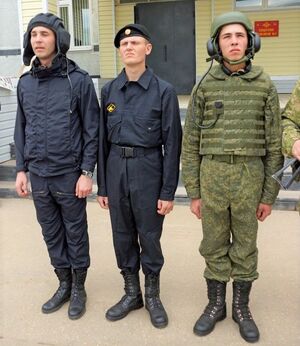
Appearances of modern Russian tankmen, from left to right; the winter version of new Tankoviy kostyum (now also featuring a detachable hood for jacket), summer version (paired with tankmen's beret) and Armata crewman wearing infantryman's EMR digital pattern paired with newest, 6B48 body armor and all-out new headset (both part of Ratnik program). As visible from the photo, the suit is nowadays not paired with Sapogi jackboots as before, but with modern all-out laces infantry combat boots.
Also, the suit now does not feature the same pants, as the pants now lack the previous two thigh-pockets and they do not feature the integrated suit-alike cotton belt anymore, but loops for separately used belt instead (as found in winter variants of the pants in the Soviet models). The only element which remained almost entirely the same is the shirt (which still has the very same two chest-pockets with peaked pockets covers, knob buttons, collar, concealed pistol pocket and etc).
Furthermore, in context of footwear, the Tankoviy kostyum is nowadays not paired with classic Sapogi jackboots anymore, but with modern all-out laces combat boots instead[35][36][37], used by the common infantry and other branches (Sapogi are nowdays being occasionally worn only by the Russian marines - the MPR forces).
In context of underwear, the current version of the Tankoviy kostyum is not paired with any kind of service uniform (like obr. 69, as was in the Soviet case), but with a simple greenish T-shirt below. Thus, it theoretically does not represent a suit anymore, but the actual tankman's uniform (since it is not worn over the basic uniform below.
In context of headwear, the Tankoviy kostyum remains paired with either the newest version of their standard TSh-4M helmet[38][39] (when operating vehicles) or classic wool-made black beret[40] (for everyday use and parades). However, it can be also paired with a classic field cap featured in the currently-used EMR digital pattern, as the alternative to the beret.[41][42][43][44][45]
One of the most notable changes also being the usage of additional, fire-resistant material, which is actually one of the main reasons why the usual infantry (camouflage) uniforms were discontinued in usage by tankmen and replaced with these suits. In comparison with the previous (Soviet) models, the modern (Russian) version of the Tankoviy kostyum now does provide full fireproof, as it is always covered with additional nylon layer above the usual cotton (Soviet versions featured nylon/fireproof only in specific versions, while the basic/standard ones were exclusively cotton made, reinforced with polyester fibers). The suit nowadays also features the modern ripstop cut, which also distinguish it from the Soviet version when more closely observed.
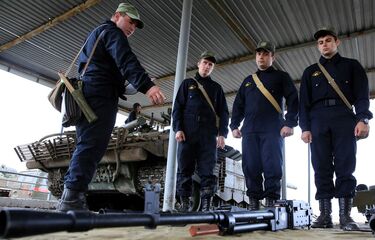
Russian tankmen gathered around dismantled NSVT heavy machine gun, wearing the summer version of the latest Tankoviy kostyum paired along with standard infantryman's EMR digital-pattern field cap (for everyday use), as the newest alternative to the usually worn beret. Behind them is a T-90M Proryv, currently the newest model of T-90 tank.
Moreover, the current version of the Tankoviy kostyum now also features additional, anti-infrared layers on the existing fire-resistant material, which severely lowers the possibility of spotting its wearer via thermal devices (as an example, the feature is very useful when crewmen have to abandon the disabled vehicle in the middle of the firefight).[46]
Except the sole design of the suit and its materials, there is also a minor change regarding the insignia worn on it - the usage of the once standard shoulder-boards (for rank insignia) is today restricted exclusively for officers, while the regular tankmen are not featuring any kind of rank insignia anymore.
Despite the fact that the originally Soviet Tankoviy kostyum is again returned to usage in the modern Russian army, other combat vehicle crewmen (the SPG's, SPAAG's and Armata universal combat platform) are nevertheless continuing to use the the EMR digital pattern or other infantry camouflage uniforms[47][48][49][50][51]. So, the usage of the Tankoviy kostyum is today exclusively restricted only for crewmen of the currently used Russian MBT's (T-72, T-80 and T-90) and IFV's/ICV's (BMP-2 and BMP-3).
However, the current (Russian Army) version of Tankoviy kostyum is almost nowhere to be seen at Russian tankmen involved in the 2022 Russian invasion of Ukraine - despite the fact that it reappeared five years ago from then (back in 2017), which point to a conclude that it is still obviously scarcely produced and issued to a very small scale (maybe even ultimately rejected for usage).
Variants[]
Summer field tankman suit:[]
Winter field tankman suit:[]
In popular culture[]
|
Media |
Notes |
Date |
|---|---|---|
| The Beast | The late (khaki) model is used by the T-55 crew | 1988 |
| Operation Flashpoint: Cold War Crisis | The early (black) model is used by Soviet crewmen, inappropriately paired with Czech vz. 90 instead of Soviet Sapogi boots | 2001 |
| World in Conflict | The late (khaki) model is used by the Soviet tankmen | 2007 |
| Call of Duty 4: Modern Warfare | The trousers of late (khaki) model are used by the OpFor | 2007 |
| Metal Gear Solid V: The Phantom Pain | The trousers of late (khaki) model are used by the armoured Soviet troops | 2015 |
References[]
- ↑ http://www.red-alliance.net/forum/index.php?topic=18495.5
- ↑ 2.0 2.1 https://www.etsy.com/sg-en/listing/463900919/uniform-canvas-pants-khaki-green
- ↑ http://www.illinoisairsoft.com/index.php?topic=14860.0
- ↑ http://www.ebay.com/itm/Russian-Soviet-USSR-Army-Tank-Troops-Suit-Uniform-Sand-1980s-1990s-/172084437363?hash=item2811082173:g:wqoAAOSwFdtXxINl
- ↑ http://www.ebay.com/itm/USSR-Soviet-army-military-daily-jacket-tank-troops-Major-tankman-198X-/351906715105?hash=item51ef4655e1:g:93MAAOSwoi1X82cD
- ↑ http://www.ebay.com/itm/Rare-Soviet-Russian-patch-chevron-jumpsuit-Tank-Troops-USSR-army-UNIFORM-emblem-/262700575244?hash=item3d2a2caa0c:g:FNgAAOSwrklVJpHh
- ↑ http://www.ebay.com/itm/Authentic-Soviet-Union-Army-Banner-Tank-Forces-Vintage-USSR-Army-Banner-Rare-/142027563885?hash=item211180a36d:g:ESkAAOSw3YNXYvnq
- ↑ http://www.ebay.com/itm/Russian-Soviet-Army-Tankman-Jacket-Afghan-war-Olive-100-Cotton-1991-dated-USSR/142210989201?_trksid=p2047675.c100005.m1851&_trkparms=aid%3D222007%26algo%3DSIC.MBE%26ao%3D2%26asc%3D38530%26meid%3Deee31a51cd7e40d488745b774011fcea%26pid%3D100005%26rk%3D5%26rkt%3D6%26sd%3D272477552249
- ↑ http://www.ebay.ie/itm/231949184085
- ↑ http://www.softairmania.it/threads/44629-%D1%80%D1%83%D1%81%D1%81%D0%BA%D0%B8%D0%B5-%D1%83%D1%81%D0%B8%D0%BB%D0%B8%D1%8F-%D0%B2-%D0%B4%D0%B5%D0%B9%D1%81%D1%82%D0%B2%D0%B8%D0%B8-(russian-forces-in-action!!)/page63
- ↑ https://www.google.bg/imgres?imgurl=http%3A%2F%2Fi.ebayimg.com%2Fimages%2Fg%2Fq-EAAOSwPcVV0Xn1%2Fs-l400.jpg&imgrefurl=http%3A%2F%2Fwww.ebay.com%2Fcln%2Fdesertfox1012%2Farmy%2F111943952010&docid=t15pUoJZRr0b6M&tbnid=mpcXWIKZkA2eWM%3A&vet=1&w=400&h=300&bih=891&biw=1680&q=brown%20soviet%20tanker%20uniform&ved=0ahUKEwjsjZ3moOjRAhVElxQKHUWmAegQMwhnKEMwQw&iact=mrc&uact=8
- ↑ https://www.ebay.ie/itm/Military-Russian-Army-Soviet-Winter-Tank-Suit-Soldier-USSR-Uniform-Jacket-Pants-/162668689145
- ↑ https://forum.ww2.ru/uploads/monthly_05_2011/post-6344-0-34437600-1304680865.jpg
- ↑ https://www.warrelics.eu/forum/attachments/uniforms-insignia-rkka-red-army-soviet-army/326358d1333219917-fur-coat-ww2-tank.jpg
- ↑ https://upload.wikimedia.org/wikipedia/commons/thumb/d/dd/USSR_Tank_Black_Emblem.jpg/1024px-USSR_Tank_Black_Emblem.jpg
- ↑ https://upload.wikimedia.org/wikipedia/commons/thumb/5/52/USSR_Tank_Emblem.jpg/800px-USSR_Tank_Emblem.jpg
- ↑ https://upload.wikimedia.org/wikipedia/commons/thumb/d/d4/USSR_Missile_forces_and_artillery_emblem.jpg/800px-USSR_Missile_forces_and_artillery_emblem.jpg
- ↑ https://ok.ru/group2yamirova/topic/75730756182016
- ↑ https://pbs.twimg.com/media/DrVc8OKX4AEcavR.jpg
- ↑ https://thecitizenhistorian.files.wordpress.com/2018/11/waffen-ss-panzer-2.jpg?w=720
- ↑ https://www.sovietmilitarystuff.com/image/cache/data/beltGreen1-1500x1000.jpg
- ↑ https://www.sovietmilitarystuff.com/image/cache/data/from%2001.06.2018/21092019-belt-1500x1000.jpg
- ↑ https://enemymilitaria.com/wp-content/uploads/2017/01/Photo-Jan-05-9-31-16-AM.jpg
- ↑ https://i.guim.co.uk/img/static/sys-images/Guardian/Pix/pictures/2011/8/16/1313489958021/A-soldier-loyal-to-the-co-003.jpg?width=700&quality=85&auto=format&fit=max&s=358dc978021d9cb9fd51abdeeec031e5
- ↑ https://img.allzip.org/g/114/orig/5764407.jpg
- ↑ https://live.staticflickr.com/1665/24935879780_c8be8cb942_b.jpg
- ↑ https://pbs.twimg.com/media/B_ZknINUcAA8gnh.jpg
- ↑ https://blogs.reuters.com/great-debate/files/2015/01/russian_commander.jpg
- ↑ https://lh3.googleusercontent.com/proxy/-s87sfGo1u_CtGDhLyp-2yI2BtoYQrqzWRl6TXHo5p6rAHeRIIW1cYj0g_PEKyn7bgDSs4d9dIEQq0y_JRmoG-QQOleGNs3HG8k5H8Gd4T2jhLlWpgJhJAnC94fvBCqV
- ↑ https://rg.ru/2017/05/20/tankistam-vernuli-chernye-kombinezony.html
- ↑ https://scontent.fzag1-1.fna.fbcdn.net/v/t1.0-0/p640x640/106204348_2681811772061562_2080904118915083984_o.jpg?_nc_cat=103&_nc_sid=8024bb&_nc_ohc=D9k8jm07WTcAX9lw03w&_nc_ht=scontent.fzag1-1.fna&_nc_tp=6&oh=a37329899ed91c53841a6055f3d09567&oe=5F4E9D4F
- ↑ https://xn--80ahclcogc6ci4h.xn--90anlfbebar6i.xn--p1ai/images/upload/2019/tankiUVO-1200_3.JPG
- ↑ https://scontent.fzag1-1.fna.fbcdn.net/v/t1.0-0/p640x640/83068342_2659099480999458_1788364909642252288_o.jpg?_nc_cat=109&_nc_sid=8024bb&_nc_ohc=yuexvfLu_KwAX9f-XC8&_nc_ht=scontent.fzag1-1.fna&_nc_tp=6&oh=dfee296443eedb0872182e08b8381c38&oe=5F4EDC7F
- ↑ https://scontent.fzag1-1.fna.fbcdn.net/v/t1.0-9/s960x960/116879681_2707837249459014_5243411133547642549_o.jpg?_nc_cat=109&_nc_sid=8024bb&_nc_ohc=qc_WIhCtxbQAX-xCR1T&_nc_ht=scontent.fzag1-1.fna&_nc_tp=7&oh=d0df91b66c6917993d3b82b80b0385a0&oe=5F4E0A8A
- ↑ https://scontent.fzag1-1.fna.fbcdn.net/v/t1.0-9/s960x960/116879168_2709513299291409_3672195775387379311_o.jpg?_nc_cat=101&_nc_sid=8024bb&_nc_ohc=ZcHLpgj16p8AX-9xv5A&_nc_ht=scontent.fzag1-1.fna&_nc_tp=7&oh=4dad20f90c21b9e1958e687f3bd66bd2&oe=5F4F45A5
- ↑ https://scontent.fzag1-1.fna.fbcdn.net/v/t1.0-0/p640x640/102453373_2659099404332799_2049246437291589632_o.jpg?_nc_cat=111&_nc_sid=8024bb&_nc_ohc=GJA1KD4d7LoAX_OWCjp&_nc_ht=scontent.fzag1-1.fna&_nc_tp=6&oh=5d9df777bb3af358b772a5a54e9298ac&oe=5F5026EF
- ↑ https://scontent.fzag1-1.fna.fbcdn.net/v/t1.0-9/s960x960/116910251_2707837179459021_8249906648367056136_o.jpg?_nc_cat=110&_nc_sid=8024bb&_nc_ohc=Jp8vBQ5koDYAX-mE7p8&_nc_ht=scontent.fzag1-1.fna&_nc_tp=7&oh=55b29effe698dfb446d8445186eabd87&oe=5F4EF3A0
- ↑ https://xn--80ahclcogc6ci4h.xn--90anlfbebar6i.xn--p1ai/images/upload/2017/_R8B3096-1200.JPG
- ↑ https://scontent.fzag1-1.fna.fbcdn.net/v/t1.0-9/s960x960/117105267_2710375832538489_6887182461567095317_o.jpg?_nc_cat=111&_nc_sid=8024bb&_nc_ohc=1Hls4QfYP_cAX9ZMaf2&_nc_ht=scontent.fzag1-1.fna&_nc_tp=7&oh=5b6025583b02599fa484a3406f8432f4&oe=5F4F54FE
- ↑ https://scontent.fzag1-1.fna.fbcdn.net/v/t1.0-0/p640x640/106588997_2681811608728245_7964687650879052546_o.jpg?_nc_cat=102&_nc_sid=8024bb&_nc_ohc=QMjqF9G70WUAX_gcgTV&_nc_ht=scontent.fzag1-1.fna&_nc_tp=6&oh=aa4f5e63786f235fe0bc93563d3af595&oe=5F51B314
- ↑ https://scontent.fzag1-1.fna.fbcdn.net/v/t1.0-9/s960x960/117099875_2710375812538491_7925306861768163482_o.jpg?_nc_cat=108&_nc_sid=8024bb&_nc_ohc=7-B3g1cEEYUAX8PrtJ3&_nc_ht=scontent.fzag1-1.fna&_nc_tp=7&oh=a6487e0c30d2cac093b47838e609413e&oe=5F4E75EE
- ↑ https://scontent.fzag1-1.fna.fbcdn.net/v/t1.0-9/s960x960/116910251_2707837179459021_8249906648367056136_o.jpg?_nc_cat=110&_nc_sid=8024bb&_nc_ohc=Jp8vBQ5koDYAX-mE7p8&_nc_ht=scontent.fzag1-1.fna&_nc_tp=7&oh=55b29effe698dfb446d8445186eabd87&oe=5F4EF3A0
- ↑ https://scontent.fzag1-1.fna.fbcdn.net/v/t1.0-0/p640x640/103029383_2664075663835173_3805725152100515163_o.jpg?_nc_cat=107&_nc_sid=e007fa&_nc_ohc=EsbI2bQqWAgAX_zd5Hp&_nc_ht=scontent.fzag1-1.fna&_nc_tp=6&oh=5ed44a268d2d0486ef7ddb0e3eba1d30&oe=5F4E1499
- ↑ https://xn--80ahclcogc6ci4h.xn--90anlfbebar6i.xn--p1ai/images/upload/2017/_R8B3120-1200.JPG
- ↑ https://xn--80ahclcogc6ci4h.xn--90anlfbebar6i.xn--p1ai/images/upload/2019/tankiUVO-1200_14.JPG
- ↑ https://rg.ru/2017/05/20/tankistam-vernuli-chernye-kombinezony.html
- ↑ https://scontent.fzag1-1.fna.fbcdn.net/v/t1.0-0/p640x640/116741214_2707023309540408_1758951409833147795_o.jpg?_nc_cat=101&_nc_sid=e007fa&_nc_ohc=2IpXloRX6C0AX_5dxXB&_nc_ht=scontent.fzag1-1.fna&_nc_tp=6&oh=862b55d1bf82c0c0d2456f97af0f589a&oe=5F4F1C84
- ↑ https://scontent.fzag1-1.fna.fbcdn.net/v/t1.0-0/p640x640/110240188_2698014797107926_208440250994581761_o.jpg?_nc_cat=105&_nc_sid=8024bb&_nc_ohc=Sm1ZGyn20DYAX8Xwt7E&_nc_ht=scontent.fzag1-1.fna&_nc_tp=6&oh=5e9ea4b42c0f80f0adedcea15874d730&oe=5F4EDEA9
- ↑ https://scontent.fzag1-1.fna.fbcdn.net/v/t1.0-0/p640x640/105455568_2676680875907985_7388095419180713806_o.jpg?_nc_cat=106&_nc_sid=e007fa&_nc_ohc=sXu2a5ASKZsAX-mAtLx&_nc_ht=scontent.fzag1-1.fna&_nc_tp=6&oh=b22b9813f25a228c0899917705039930&oe=5F507228
- ↑ https://scontent.fzag1-1.fna.fbcdn.net/v/t1.0-0/p640x640/104627715_2671756466400426_2284215062083477724_o.jpg?_nc_cat=104&_nc_sid=8024bb&_nc_ohc=0PqnYXs25qoAX9hDpX-&_nc_ht=scontent.fzag1-1.fna&_nc_tp=6&oh=d94da8f46fb2997fe9ba33fd6abe9244&oe=5F516FE4
- ↑ https://scontent.fzag1-1.fna.fbcdn.net/v/t1.0-9/s960x960/104595785_2671097969799609_8127989483731297498_o.jpg?_nc_cat=109&_nc_sid=e007fa&_nc_ohc=Sx9tOCkySjIAX-aXZ4A&_nc_ht=scontent.fzag1-1.fna&_nc_tp=7&oh=12a44c4d49ab090d65747309c431167c&oe=5F4EC9B1
- ↑ http://www.terapeak.com/worth/star-uniform-russian-army-ussr-tarpaulin-technician-repair-tank-54-3-new/181902233808/
- ↑ https://www.google.bg/imgres?imgurl=http%3A%2F%2Fimg.photobucket.com%2Falbums%2Fv215%2Fshervin2%2FPicture196.jpg&imgrefurl=http%3A%2F%2Fwww.wehrmacht-awards.com%2Fforums%2Fshowthread.php%3Ft%3D480836&docid=S6hI79CuytsYMM&tbnid=Vm5KigF6VZFJDM%3A&vet=1&w=500&h=750&bih=891&biw=1680&q=russian%20tanker%20uniform&ved=0ahUKEwjjk9a46JfRAhWErRoKHWydC6QQMwhSKDEwMQ&iact=mrc&uact=8#h=750&vet=1&w=500
- ↑ http://www.ebay.com/itm/tank-crew-winter-army-uniform-soviet-russian-black-quilted-jacket/222001107595?hash=item33b04c128b
- ↑ http://www.ebay.ie/itm/231678557774
- ↑ http://www.ebay.ca/itm/USSR-ARMY-MILITARY-LUXURY-WINTER-TANKER-SAND-JACKET-SHEEPSKIN-FUR-SIZE-52-3-/262747673469?hash=item3d2cfb537d
- ↑ http://www.ebay.com/itm/tank-crew-winter-army-uniform-soviet-russian-khaki-quilted-jacket-and-pants/221925778531?hash=item33abcea463
- ↑ http://www.ebay.com/itm/nos-tank-crew-jacket-48-2-winter-army-uniform-1987-soviet-afganka-khaki-quilted/231687183530?hash=item35f1a1dcaa
- ↑ http://www.ebay.ca/itm/USSR-ARMY-MILITARY-LUXURY-WINTER-TANKER-DARK-GREY-JACKET-SHEEPSKIN-FUR-/262540560653?hash=item3d20a3090d
- ↑ http://www.ebay.com/itm/nos-1994-tank-crew-winter-warm-uniform-belarus-army-kirza-quilted-jacket-48-3-m/231695685521?hash=item35f2239791
- ↑ http://iacmc.forumotion.com/t10093-soviet-tanker-winter-jacket-khaki
- ↑ http://picclick.ca/Ex-Rare-Russian-Army-Winter-Tanker-Jacket-Camo-262517975479.html
- ↑ http://www.ebay.com/itm/Vintage-Soviet-military-army-tank-pea-jacket-staff-Sergeant-size-48-winter-USSR-/332033355323?hash=item4d4ebaee3b:g:G8kAAOSwv-NWUGCL
- ↑ http://www.ebay.com/itm/NOS-1987-TANK-TANKMEN-CREW-SOVIET-ARMY-UNIFORM-PANTS-44-2-KHAKI-WARM-PADDED-/231687149503?hash=item35f1a157bf:g:HoUAAOSwQPlV9Zo1
- ↑ http://www.ebay.com/itm/NOS-1983-TANK-TANKMEN-CREW-SOVIET-ARMY-UNIFORM-48-4-PANTS-WARM-PADDED-WINTER-/231693606283?hash=item35f203dd8b:g:0fIAAOSwBLlVcIpk
- ↑ https://www.google.bg/imgres?imgurl=http%3A%2F%2Fthumbs.picclick.com%2F00%2Fs%2FOTAwWDEyMDA%3D%2Fz%2F-pcAAOSwbYZXcTRg%2F%24%2FSoviet-Military-Uniform-Tank-Man-Officers-Jacket-Size-_1.jpg&imgrefurl=http%3A%2F%2Fpicclick.ca%2FSoviet-Military-Uniform-Tank-Man-Officers-Jacket-Size-222200936064.html&docid=1tWhTTVL3tKdAM&tbnid=8LTgApZ2V4vQSM%3A&vet=1&w=400&h=300&bih=891&biw=1680&ved=0ahUKEwidsZ-qo5LQAhXEHxoKHVC3APcQMwiFAShiMGI&iact=mrc&uact=8
- ↑ http://www.ebay.com/itm/Russian-Soviet-tanker-jacket-tunic-pants-uniform-afghanka-Afghan-War-/112188207054
- ↑ https://www.google.bg/imgres?imgurl=http%3A%2F%2Fi46.photobucket.com%2Falbums%2Ff128%2Firishpuding%2FDSCN0402.jpg&imgrefurl=https%3A%2F%2Fwww.boards.ie%2Fb%2Fthread%2F2055707189%2F4&docid=Y5oYlmgdPgcsFM&tbnid=I139Fz7WcDaRqM%3A&vet=1&w=1024&h=768&bih=891&biw=1680&q=gorka%204%20bars%20summer%20partizan&ved=0ahUKEwiDvOeh9OzQAhUGaxQKHTFRCgw4ZBAzCBEoDjAO&iact=mrc&uact=8#h=768&vet=1&w=1024
Videos[]
The Tankoviy kostyum makes many appearances in various Soviet military footage of the Cold War era, as well as in certain pieces of the Soviet cinematography. Among many others, there are few chosen pieces in which it is more closely observed:

Обзор на танковый комбинезон СА обр.1972 года.
The Tankoviy kostyum is briefly shown and described in this ten-minute Russian video about Soviet Cold-War era tankman's appearance.

Танкодром (1981)
Both the summer and the winter version of the early/black model of Tankoviy kostyum together make forefront appearance in this 1981 Soviet three-part TV-series Tankodrom ("The Tank-drome").

Комбаты (1983) киноповесть
The same summer version of the early/black model of the Tankoviy kostyum also makes continuous appearance through this 1983 Soviet movie Kombati (abbreviation for Battalion commanders, in Russian), which follows a story of a group of Soviet tankmen's everyday life and duties.

Атака (1986)
Both the early/black as well as the late/khaki version of the summer model of Tankoviy kostyum together make forefront appearance in the 1986 Soviet movie Ataka ("Attack"), which follows a group of Soviet tankmen preparing for a military exercise. By that, the film also portrays a real-time transition period between the early (black) and the late (khaki) model of the suit - which also existed in the actual Soviet Army of that time.







![Soviet winter tanker jacket.jpg (247 KB) A late/khaki version of the jacket (winter suit version)[63]](https://static.wikia.nocookie.net/equipment/images/a/ad/Soviet_winter_tanker_jacket.jpg/revision/latest/scale-to-width-down/139?cb=20161218191351)









![Soviet winter tanker trousers.jpg (196 KB) A 1987 manufactured late/khaki version of the winter trousers[64]](https://static.wikia.nocookie.net/equipment/images/1/1a/Soviet_winter_tanker_trousers.jpg/revision/latest/scale-to-width-down/104?cb=20161218192452)
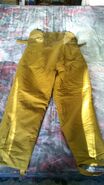









![Soviet green winter trousers.jpg (240 KB) A 1983 manufactured early/black version of the winter trousers[65]](https://static.wikia.nocookie.net/equipment/images/5/51/Soviet_green_winter_trousers.jpg/revision/latest/scale-to-width-down/104?cb=20161218193919)




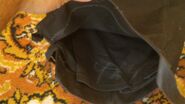

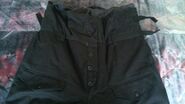



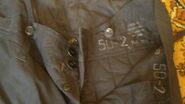
![Soviet tanker jacket.JPG (127 KB) A 1990 manufactured late/khaki version of the shirt[66]](https://static.wikia.nocookie.net/equipment/images/c/cd/Soviet_tanker_jacket.JPG/revision/latest/scale-to-width-down/149?cb=20161106194833)


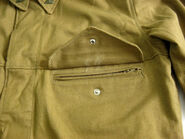

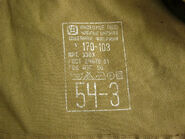

![Soviet tanker jacket 1989.jpg (29 KB) A 1989 manufactured late/khaki shirt[67]](https://static.wikia.nocookie.net/equipment/images/c/ce/Soviet_tanker_jacket_1989.jpg/revision/latest/scale-to-width-down/149?cb=20161106200931)





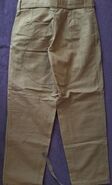


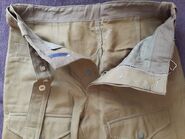

![Il fullxfull.1049354437 k8s4.jpg (265 KB) Another summer late/khaki trousers, manufactured in 1991[2]](https://static.wikia.nocookie.net/equipment/images/a/a7/Il_fullxfull.1049354437_k8s4.jpg/revision/latest/scale-to-width-down/185?cb=20161120152435)




![DSCN0402.jpg (148 KB) Very rare example of Tankoviy kostyum featured in TTsKO camouflage pattern (right) next to VSR standard camouflage uniform (left).[68]](https://static.wikia.nocookie.net/equipment/images/e/eb/DSCN0402.jpg/revision/latest/scale-to-width-down/185?cb=20161211195900)